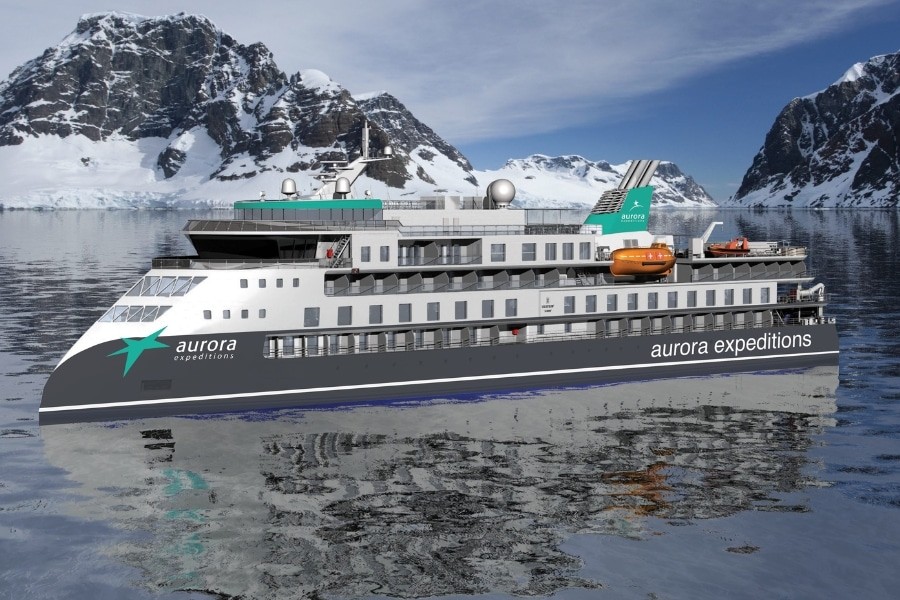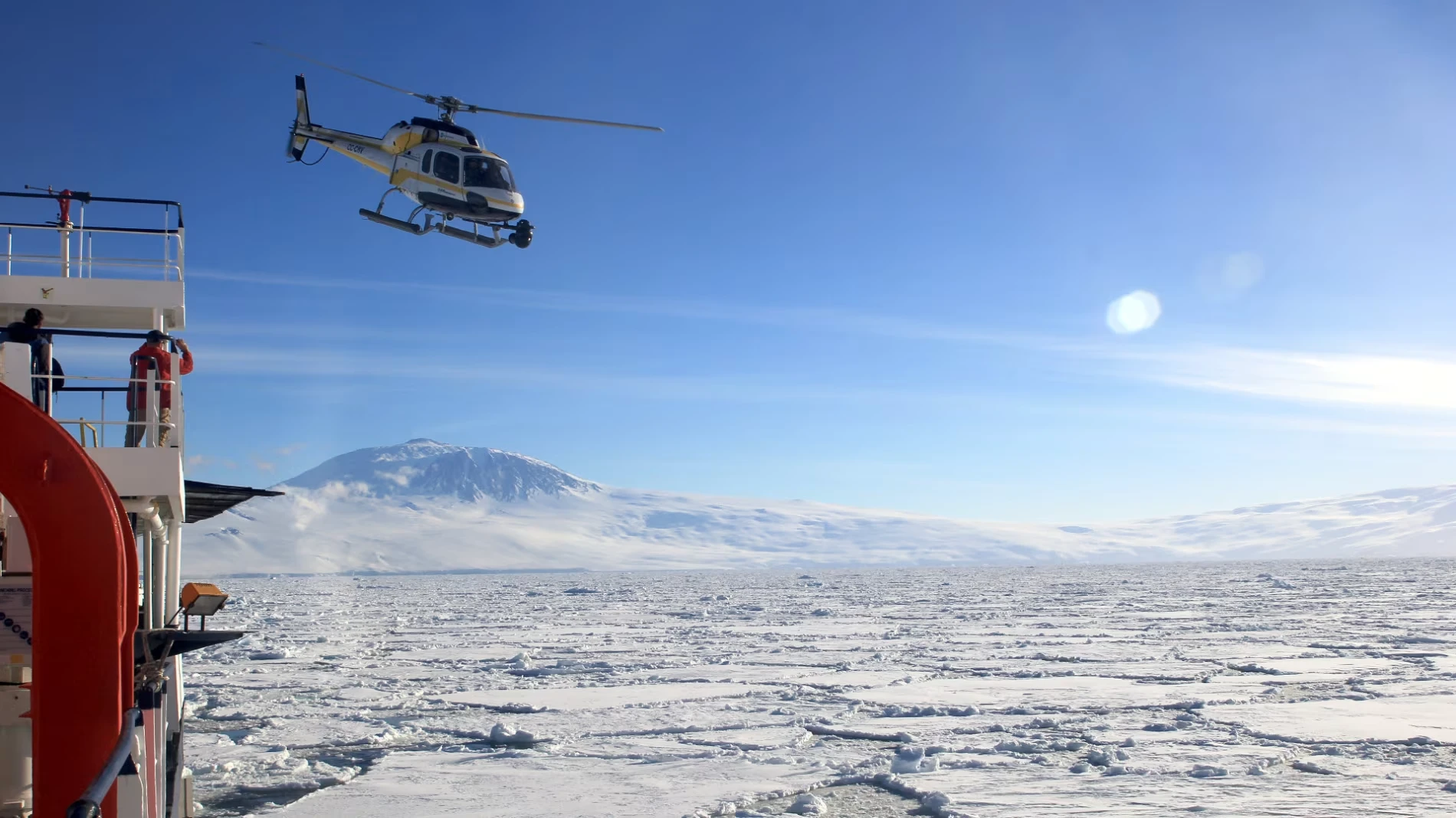Douglas Mawson: Aurora's 3rd Ship Bringing Back Ross Sea Exploration
Oct 30, 2025
Aurora's 3rd sister ship improves the Antarctica experience by allowing farther exploration
Aurora Expeditions christens its newest X-BOW ship in Sydney on November 25, 2025, but the Douglas Mawson isn't just another Antarctic vessel joining the fleet. This ship brings something that's been missing from Aurora's lineup for 15 years: regular access to East Antarctica's Ross Sea and the expedition sites that made its namesake explorer legendary.
If you've been waiting for Aurora to return to the less-traveled side of Antarctica, or if you're a solo traveler tired of paying double for the privilege of traveling alone, this ship changes the game.
The Third X-BOW, But With a Purpose
The Douglas Mawson is Aurora's third purpose-built expedition ship featuring Ulstein's distinctive X-BOW design, joining the Greg Mortimer (2019) and Sylvia Earle (2022). Delivered from China Merchants Heavy Industry in September 2025, she carries 130 passengers on polar expeditions and up to 154 on small ship cruises to warmer destinations.
The X-BOW isn't just about looking different. That inverted bow cuts through Southern Ocean swells instead of slamming over them, reducing motion by about 50% compared to traditional hull designs. For the Drake Passage crossing, this translates to fewer people turning green and more people actually enjoying the two-day journey south.
With Polar Class 6 ice certification, the Douglas Mawson can navigate the ice-choked waters of both Antarctica's coasts. She's equipped with the same diesel-electric propulsion and waste-heat recovery systems as her sister ships, making her efficient enough for the long voyages to remote East Antarctica.
But here's what makes this ship different: she's named specifically for the routes she'll pioneer.
Why the Ross Sea Matters
Sir Douglas Mawson led the Australasian Antarctic Expedition from 1911-1914, establishing the first base on East Antarctica at Cape Denison. His expedition mapped huge swaths of the Antarctic coastline and conducted groundbreaking scientific research. More importantly for modern travelers, his base at Mawson's Huts still stands as one of the best-preserved historic sites from the Heroic Age of Antarctic Exploration.
Aurora hasn't operated regular Ross Sea expeditions for about 15 years. The Douglas Mawson changes that, with inaugural season voyages specifically designed to retrace Mawson's routes and access sites that most Antarctic travelers never see.
The Ross Sea is Antarctica's other side. While the Peninsula hosts 50+ ships during peak season, the Ross Sea sees maybe 5-10 vessels all year. You're looking at emperor penguin colonies instead of the more common Adelie and gentoo penguins. You're visiting actual expedition huts where explorers overwintered, not just landing sites. You're crossing the Antarctic Circle and pushing into regions where sea ice, not tourist crowds, determines your itinerary.
Douglas Mawson's inaugural season includes three Ross Sea-focused expeditions: the 24-day "Mawson's Antarctica" voyage tracing his historic route to Cape Denison, a 25-day "Ross Sea Odyssey" exploring the region's wildlife and science stations, and an epic 34-day "Crossing the 7th Continent" expedition that combines both coasts of Antarctica.
These aren't casual Peninsula trips. Ross Sea expeditions run 24-34 days compared to the typical 10-12 day Peninsula voyage, and pricing reflects that reality. The inaugural season Ross Sea voyages range from $26,636 to $43,795 per person (with 20% launch discounts already applied). That's 2-3 times Peninsula pricing, but you're also accessing regions that only a handful of ships can reach.
Who should consider Ross Sea on the Douglas Mawson? Second-time Antarctica visitors who've already done the Peninsula. History enthusiasts who want to stand where Mawson, Shackleton, and Scott established their bases. Photographers seeking locations that haven't been photographed to death. And travelers who have 3-4 weeks available and the budget to support this level of expedition.
If you're a first-timer on a tighter timeline and budget, the Peninsula remains the right introduction to Antarctica. But if you want something beyond the greatest hits, the Douglas Mawson's Ross Sea program is your Aurora opportunity.
The Solo Traveler Advantage
Here's where the Douglas Mawson really differentiates itself from Aurora's existing fleet: it has more dedicated single cabins than any other ship in the fleet.
Solo travel in Antarctica typically comes with a painful single supplement of 50-100% on top of the per-person fare. On a $20,000 voyage, that's an extra $10,000-20,000 just for having your own cabin. The Douglas Mawson addresses this with 10+ purpose-built single cabins that carry no single supplement on inaugural season voyages.
These aren't converted double cabins. They're designed from the ground up for solo travelers, available in two configurations. The Aurora Single Stateroom comes with a porthole window and measures 106 square feet with a private bathroom. If you want more space and a view, the Balcony Single Stateroom offers 163 square feet with a French balcony.
For solo travelers in the 50-70 demographic (where many are traveling alone after divorce or widowhood), this is significant. The no-supplement cabins save anywhere from $6,500 to $18,000 depending on voyage length. Even outside the inaugural season deals, Aurora's standard 50% single supplement is more reasonable than the 100% some luxury operators charge.
Fair warning: these cabins sell out fast. If you're solo and interested in Douglas Mawson voyages, book 12-18 months in advance. Once the dedicated single cabins are gone, you're back to the 50% supplement or Aurora's cabin-share program where they'll match you with a same-gender traveler.
Life Aboard Douglas Mawson
The ship features the same thoughtful expedition design as her sister ships, with a few refinements. The two-story glass atrium creates a light-filled central gathering space, while the bow lounge offers floor-to-ceiling windows for wildlife watching from inside when the weather drives you off the decks.
Outside, there's a heated pool flanked by two jacuzzis and a pool bar. After a day of zodiac cruising in Antarctica, soaking in a hot tub while icebergs drift past is exactly as surreal as it sounds. The fitness center and sauna provide additional wellness options for the multi-week Ross Sea voyages where you need ways to stay active.
Aurora includes what many competitors charge extra for. Kayaking (usually $500-900 elsewhere), camping ($250-500), and snowshoeing ($200-400) are all included in your fare. The mudroom and multiple zodiac embarkation points mean you're getting on and off the ship efficiently, maximizing shore time rather than waiting in lines.
The Citizen Science Center reflects Aurora's commitment to participatory research. You're not just observing Antarctica, you're collecting water samples, counting penguins, and contributing data to ongoing scientific projects. The lecture theater hosts presentations from the expedition team and visiting specialists.
Connectivity-wise, Douglas Mawson has free unlimited Starlink across the ship. For travelers who need to stay in touch with family or handle essential business, this is the modern Antarctic reality. Video calls work, photos upload to social media, email functions normally. It's not quite home internet speeds, but it's genuinely functional in a way that traditional satellite internet never was.
What's not included: alcoholic beverages and gratuities. Budget an extra $1,000-2,000 per person for drinks and tips over a typical voyage.
Inaugural Season Window
The Douglas Mawson's maiden voyage departs December 2025 for an 11-day Tasmania circumnavigation priced at $8,396 (20% off retail). It's a smart way to test the ship on a shorter, less expensive voyage before committing to a major Antarctic expedition.
The Ross Sea voyages launch January-February 2026 with the same 20% inaugural discounts. The Subantarctic Islands voyage (15 days, $12,556) offers a middle ground between Peninsula pricing and full Ross Sea commitment.
Traditional Peninsula routes begin later in the 2026-27 season at 15% off retail pricing.
Should You Book the Douglas Mawson?
Book this ship if you're a solo traveler who wants to avoid the single supplement, if you're specifically interested in Ross Sea exploration, or if you value being on Aurora's newest vessel with the latest sustainability features and connectivity.
Consider Aurora's existing ships (Greg Mortimer or Sylvia Earle) if you want Peninsula routes at potentially better pricing, if you're flexible on dates and hunting for last-minute deals, or if you're traveling as a couple and the single cabin availability doesn't matter.
The Douglas Mawson isn't just another ship in Aurora's fleet. It's the vessel that brings Ross Sea expeditions back to Aurora's program and gives solo travelers a fair shot at Antarctica without paying double. For the right traveler, that makes all the difference.
Not sure if Ross Sea is worth the premium over Peninsula routes? Flipper, our AI penguin guide, can walk you through the real differences based on your priorities, timeline, and budget. He knows Aurora's fleet inside and out. When you want insights from someone who's actually sailed these routes, our team of Antarctic veterans is here—no sales pressure, just honest guidance about which Aurora ship and itinerary makes sense for your trip.
Operators in this story
Vessels mentioned in this story
Look up which expeditions have your prefered amenities
Sign up to our newsletter for updates








